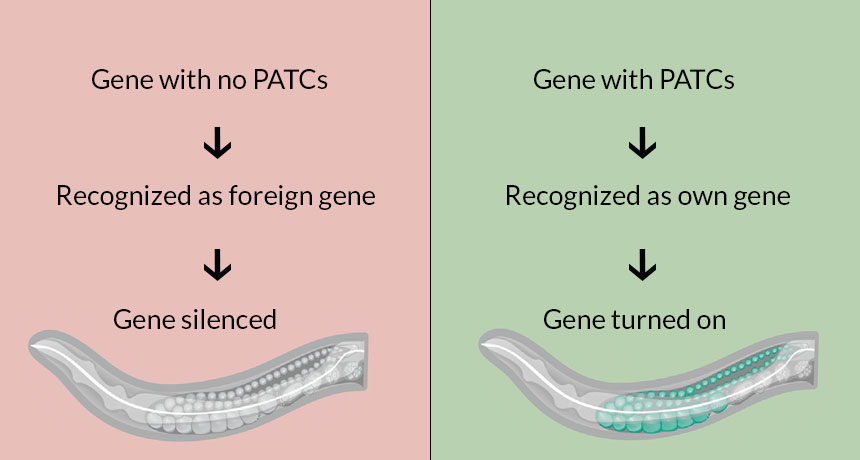
NO ALIENS ALLOWED Roundworms (C. elegans) have to fight off foreign DNA while protecting its own genes that will be passed to the next generation. Some bits of “junk DNA” — called PATCs — may help. PATCs help keep the worms’ own genes active while alien genes are turned off.
C. Frøkjær-Jensen et al/Cell 2016
- More than 2 years ago
“Junk DNA” may be an essential part of a worm’s inheritance.
Parts of this not-so-disposable DNA serves as a “watermark” to authenticate a Caenorhabditis elegans roundworm’s own genes and distinguish them from foreign genes that need to be shut down, researchers report in the July 14 Cell.
Genes bearing the watermarks — called PATCs — are protected against being shut down. These genes also tend to be active in the germ line (eggs and sperm and the cells that give rise to them). Genes without authentication codes get turned off, especially in the germ line, the researchers discovered. That raises the possibility that other species, perhaps even humans, issue their own germline gene work permits.
Researchers have known that C. elegans’ set of genetic instructions, its genome, is littered with PATCs (short for periodic An/Tn clusters), but didn’t know why. PATCs are short stretches of the DNA building blocks adenine or thymine separated by other building blocks, or bases; each run goes about 10 bases on average until the start of the next A or T cluster (for instance, TTTTTaatggAAAA etc.). About 10 percent of the worm’s genome is marked with the A or T clusters, says study coauthor Christian Frøkjær-Jensen, a geneticist at Stanford University.
While other animals don’t seem to have the regular patterns of A’s and T’s exactly like C. elegans does, “the general idea that species can mark segments of their genomes and protect them from silencing … could apply to other organisms,” says Andrew Spence, a geneticist at the University of Toronto who was not involved in the study.
In 2006, Stanford University geneticist Andrew Fire and colleagues pointed out that the A-T tattoos were often associated with genes that are active in the germ line. Those watermarks were found in filler DNA, called introns, sandwiched between the parts of a gene containing the information used to make protein. Introns are snipped out and thrown away before an RNA copy of a gene is read by protein-building machinery. Introns sometimes contain information about how to regulate genes. That seems to be what the PATCs are doing.
Fire and colleagues postulated that the PATCs helped C. elegans protect its own genes from being disabled by molecular defense mechanisms that halt the incursion of foreign DNA. (Fire won the 2006 Nobel Prize in physiology or medicine (SN: 10/7/06, p. 229) for the discovery of one such mechanism, a gene-silencing system called RNA interference or RNAi.) Alien DNA from viruses or selfish bits of genetic material known as transposons, or jumping genes, can wreak havoc on a genome, damaging genes that they hop into. It is important to stop the jumping genes in the germ line because DNA in those cells will be passed on to future generations.
To combat the jumpers, C. elegans and other organisms deploy an army of small interfering RNAs that shred RNA copies of foreign genes. Other small RNAs, known as piRNAs, direct cell machinery that stretches molecular hazard tape across DNA where transposons and other aliens settle. Such off-limits territory is called heterochromatin, and genes there are turned off. Sometimes, though, some important native genes that need to stay on get trapped behind the lines. PATCs may be the operating permits that let native genes in heterochromatin remain active.
In 2006, Fire and colleagues had no data to back up their idea. The new study puts Fire’s hypothesis to the test. “Oh my gosh, did they test it. It is really a thorough and complete analysis,” says geneticist Susan Strome of the University of California, Santa Cruz.
In the new study, Fire, Frøkjær-Jensen and colleagues engineered a gene for a fluorescent jellyfish protein with an intron containing PATC watermarks. When the researchers inserted the PATC-containing gene in a heterochromatin region of the genome, the gene turned on and made the worm’s germline cells glow. But the same jellyfish gene without PATCs was turned off. Those results are evidence that PATCs protect genes against getting turned off. Exactly how that happens isn’t yet known.
Strome isn’t sure that other organisms need DNA certificates to allow their genes to turn on in rough neighborhoods. C. elegans worms have unusual chromosomes. Nearly two-thirds of each chromosome is heterochromatin wasteland. The PATC permits may be necessary only in such extreme cases, she says.
Fire says he’s not yet ready to declare that all junk DNA may be useful. “Certainly there is gold in what we see here,” he says, “but the question is whether it is all gold.”






